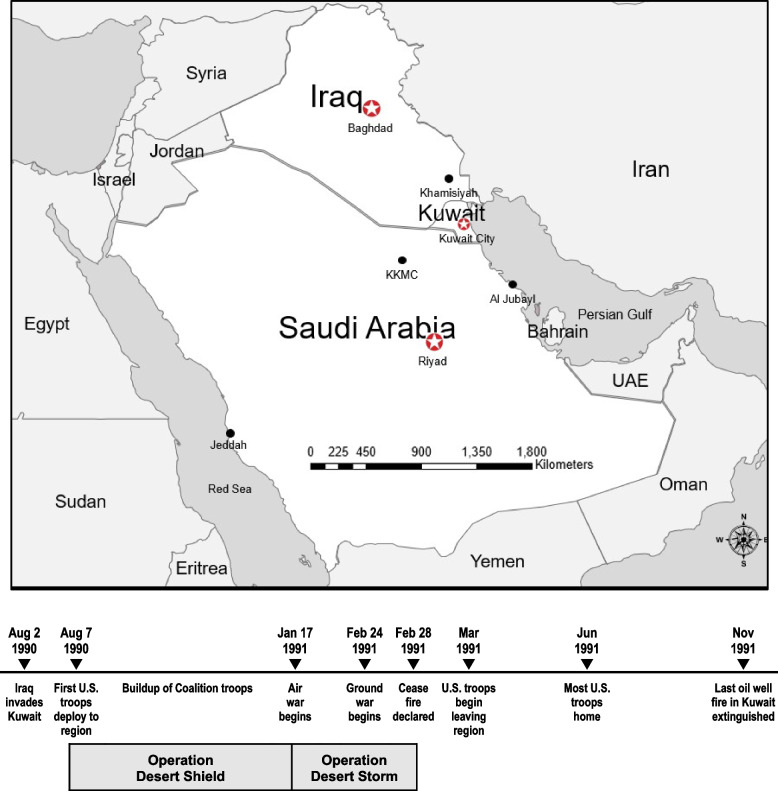Symptoms Linked to Specific Times, Locations, Exposures

Last year, Illinois veterans attend a Desert Storm remembrance ceremony at the Illinois State Military Museum in Springfield, honoring the 18 servicemembers from the state of Illinois who passed away. Recent research indicates the Gulf War illness continues to affect a large proportion of Desert Shield/Dessert Storm veterans in patterns associated with 1990-1991 deployment and exposures. Photo by Sgt. Trenton Fouche of the Illinois National Guard Public Affairs
HOUSTON — For many veterans who served during the 1990-1991 Gulf War era, Gulf War Illness (GWI) and chronic ill health have lasting effects nearly 30 years later, according to a recent study.
The study published in the journal Environmental Health evaluated patterns of chronic ill health and GWI in the Gulf War veteran cohort of the VA Million Veteran Program (MVP), focusing on wartime exposures and key features of deployment, the researchers explained.1
GWI is characterized by multiple chronic symptoms, including a combination of persistent pain, fatigue and cognitive difficulties, often in combination with gastrointestinal problems, respiratory symptoms and skin abnormalities. Large studies of Gulf War veterans have determined that about one-third of the nearly 700,000 U.S. veterans who served in the Gulf War developed GWI, the study reported.
“GWI has been a persistent and challenging health issue for veterans of the 1990-1991 Gulf War and their healthcare providers,” Lea Steele, PhD, a professor at Baylor College of Medicine in Houston, told U.S. Medicine. “This study aimed to identify if chronic illness experienced by 1990-1991 Gulf War veterans in 2018-2020 was connected to specific Gulf War exposures or deployment factors nearly 30 years earlier.”
“By assessing the large group of 1990-1991 Gulf War veterans in the VA’s Million Veteran Program, we aimed to identify any clear linkage patterns in health outcomes and exposures. These insights will help ongoing research, especially studies on gene-exposure interactions related to GWI,” Steele added.
The study included MVP participants who completed the MVP Gulf War Era Survey from 2018 to 2020, providing details about their health, Gulf War exposures, and deployment time periods and locations. The Gulf War veteran cohort of 14,103 veterans represents the largest sample of U.S. Gulf War veterans studied to date, with similarities to the overall population of U.S. Gulf War veterans, according to the investigators. The authors performed statistical analyses to determine associations of three defined GWI/ill health outcomes with Gulf War deployment characteristics and exposures
The authors concluded that GWI and chronic ill health continue to affect a large proportion of Gulf War veterans in patterns associated with 1990-1991 Gulf War deployment and exposures.
30 Years Later
“Nearly 30 years after the 1990-1991 Gulf War, many veterans still experience chronic illness associated with their service,” Steele said. “Nearly half of the 14,103 1990-1991 Gulf War veterans surveyed rated their health as fair or poor. Thirty-one percent met CDC (Centers for Disease Control and Prevention) criteria for severe GWI, and 20% had received a GWI diagnosis from a healthcare provider.”
Steele reported that rates of GWI and veteran-reported ill health were highest among Army and Marine Corps veterans, enlisted ranks, younger veterans and those deployed in certain time periods and locations.
The analysis identified clear patterns of GWI and ill health based on veterans’ deployment locations and time periods of service during the 1990-1991 Gulf War. The highest illness rates were consistently identified among Gulf War veterans who served for at least 7 days in Iraq and Kuwait, where nearly all battles had occurred, as well as among veterans who were in theater during the period of active hostilities (January to February 1991) and remained through the summer of 1991, according to the authors.
In addition, the study revealed that GWI had the strongest associations with three exposures during Gulf War deployment: reported exposure to chemical/biological agents, use of pyridostigmine bromide pills (to protect against nerve agents) and pesticides, Steele pointed out.
“The study’s results show that GWI isn’t a general effect of deployment or just a result of aging,” Steele said. “Instead, it’s consistently linked to specific times and locations of deployment, as well as to certain exposures during the Gulf War.”
It’s important for healthcare providers working with 1990-1991 Gulf War veterans who are experiencing health problems to ask questions, Drew A. Helmer, MD, MS, professor of medicine and health services research at Baylor College of Medicine, told U.S. Medicine.
“When treating deployed Gulf War veterans, ask if they have ongoing symptoms and discuss their deployment history—where and when they served and if they recall any exposures of concern,” Helmer said. “Note their answers in your progress notes, which demonstrates your attention to their concerns and validates their experiences.”
Helmer noted that several treatment and other Gulf War information resources are available to share with patients.
These include:
- The VA/DoD Clinical Practice Guideline for the Management of Chronic Multisymptom Illness provides a thorough overview of evidence-supported treatments for chronic symptoms relevant to veterans with GWI: https://www.healthquality.va.gov/guidelines/mr/cmi/.
- The VA Health Outcomes Military Exposure Program website provides information on Gulf War exposures: https://www.publichealth.va.gov/exposures/gulfwar/index.asp.
- Information on Gulf War-related research can be found at the Gulf War Veterans’ Illnesses Research Advisory Committee website: https://www.va.gov/RAC-GWVI/index.asp.
“Our findings highlight the urgent need to better understand the biology behind GWI and to identify effective treatments for this condition,” Steele added. “This remains a priority as we work to improve care for 1990-1991 Gulf War veterans with long-term health challenges.”
- Steele L, Quaden R, Ahmed ST, Harrington KM, et. Al. Department of Veterans Affairs Cooperative Studies Program #2006 and the VA Million Veteran Program. Association of deployment characteristics and exposures with persistent ill health among 1990-1991 Gulf War veterans in the VA Million Veteran Program. Environ Health. 2024 Oct 25;23(1):92. doi: 10.1186/s12940-024-01118-7. PMID: 39456027; PMCID: PMC11520114.


